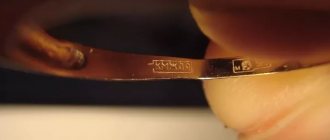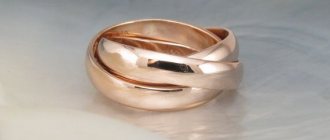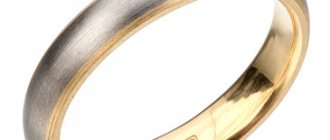“What types of gold are there?” - This is one of the most popular questions asked by buyers who love unusual things. We answer: there are at least a dozen types of gold flowers, but not all of them are used for the production of jewelry. Some alloys are not suitable because they are brittle, others because they are expensive.
However, when we talk about how many types of gold there are, we are actually discussing the number of shades of its alloys. Pure gold always has a sunny yellow color; the Latin name of this chemical element, aurum, means “yellow.” Well, the shade changes after adding a ligature - components that give the naturally soft precious (noble) metal the strength necessary for the production of jewelry.
Yellow gold
Yellow is an alloy of Au with copper and silver. Such an alloy can be either 585 standard (i.e. with 58.5% pure Au) or 750 standard (with 75% precious metal). Depending on the proportions of the ligature, the shade changes: add more silver and you get a color that is commonly called “lemon.” Well, copper adds warmth to the jewelry palette. Of all the types of gold colors, it is the yellow 750 alloy that is most often used in Europe for the manufacture of wedding rings. Gradually the fashion for it comes to Russia. Appreciate the beauty of yellow alloy in a designer diamond ring.
Red gold ring with hearts and inserts 911633K
Combined rings with a path of diamonds 931479B , without inserts 931479
Designer ring made of lemon gold 931638B
Gold. All about gold
Gold is the only precious metal with a distinct bright yellow color. “Aurum est metallum pretiosum” (Latin) – “Gold is a precious metal” The history of metals and jewelry is as old as human civilization. Gold mining was mastered by mankind several millennia BC, thanks to its distribution in native form. According to archaeologists, systematic mining began in the Middle East. It was from there that gold jewelry began its offensive, particularly in Egypt. Gold jewelry dating back to the third millennium BC was found there.
A characteristic feature of gold is the highest ductility and malleability of all known noble metals. Gold in its pure form can be easily cut with a knife. It has good electrical and thermal conductivity and high gloss.
- gold density 19.32
- gold atomic number 79
- melting point of gold 1,062°C
- gold hardness according to Brinell 20
- Mohs hardness of gold 2.5
Gold has very high chemical resistance - even when heated, neither oxygen nor sulfur affects it. Gold is resistant to moisture and does not react with acids, salts and alkalis. But it dissolves in some acid mixtures. For example, in “royal vodka” (Latin - Aqua Regis), created by alchemists. It is a mixture of hydrochloric (HCl) and nitric acids (HNO 3
) in a ratio of 3:1. Also in other mixtures of acids - manganese and sulfuric, nitric and sulfuric, in selenic acid when heated. Gold can still dissolve in aqueous solutions of metal cyanide in the presence of oxygen or other catalysts.
Gold easily combines with mercury to form an amalgam. Reacts chemically with bromine, chlorine and iodine.
In nature, gold occurs as a metal in the form of ore (primary, bedrock) and hydrothermal formations. In primary deposits, gold is found in the form of hard-to-see inclusions and inclusions, visible only with the help of special instruments, in primary vein minerals and crystalline rocks. Deposits are classified as industrial if the gold content exceeds 2 grams per ton of rock. Secondary, alluvial formations (sorry for the tautology) were formed as a result of destruction due to the washing out or weathering of ore (primary) deposits. The destruction led to the release of gold from the rock, which, together with the rock, rushes along with running waters, lies along the entire route of runoff in various natural depressions and irregularities along the entire path of its movement following the waters. The high density of gold does not prevent it from moving over long distances and settling at the bottom along the beds of rivers and streams, forming concentrated accumulations of placer gold. Gold in such places has different shapes and sizes, is in the form of irregularly shaped small grains, plates, flakes, distorted crystals, and the like. Placer gold is purer than ore gold and has a higher purity.
Pure gold cannot be found in nature. It always contains impurities, which determine the color of natural gold. Natural gold is a source for obtaining pure gold. Gold extracted from mines is called schlich gold. The purity of spot gold varies and ranges from 500 to 970 purity (50% - 97% pure gold in the total mass). Due to the fact that spot gold consists of particles of different chemical compositions, it requires additional processing and purification from impurities. This is achieved through the use of refining technology in special certified refineries.
Refining (from the French affinage - “to purify”) is a technological process in metallurgy for producing high-purity precious metals by separating impurities from them. The highest degree of purification of gold is achieved by the electrolytic method. Platinum and other platinoids are subjected to chemical purification - dissolution in acids and subsequent isolation from the resulting solution using special reagents.
Pure gold is a relative concept. The purity of gold is expressed by its fineness; there is no 1000th fineness. The grade of pure gold ZL 999 means that its composition is 99.9% gold, and the remaining 0.1% is impurities. The grade of pure gold is Zl 999.9, containing 99.99% gold, the remaining 0.01% being impurities. Impurities can include metals such as silver, copper, lead, bismuth, and iron.
Refined gold is produced in bars of different weights. The degree of purity according to special technical conditions can reach 99.9999%. The bulk of pure gold is used to prepare gold-containing alloys used to produce jewelry, medals, souvenir and commemorative coins, gold leaf and dentures, still popular in some counties, and decorative electroplating. Gold is widely used in instrument making and microelectronics due to its excellent electrical conductivity.
Gold alloys
Even before our era, ancestors used an alloy of gold and silver when minting ancient ancient coins. Electron is a natural alloy of gold and silver. According to ancient sources, the ratio of gold to silver in electron was 4 to 1 or 3 to 1. Recent studies have shown that the pure gold content in electron coins ranges from 16-69%.
Nowadays, noble gold alloys contain the following alloying additives: platinum, silver, copper, palladium, zinc, nickel, cadmium and other metals. Each introduced component has its own effect on the properties of the gold alloy.
The addition of silver gives the gold alloy malleability, ductility and ductility, lowers the melting point, and changes the color of the gold alloy. Increasing the proportion of silver in a gold alloy leads to a change in color. At first, gold turns green, then acquires a yellow-green color. If the proportion of silver in a gold alloy exceeds 30%, the color of the alloy becomes yellow-white and begins to fade as the proportion of silver increases. The white color of a gold alloy will be when the silver content in the alloy is at least 65%.
The addition of copper gives the gold alloy additional hardness, maintaining malleability and ductility, but at the same time worsens the anti-corrosion property. When copper is added to a gold alloy, it acquires a reddish tint, which intensifies with an increase in the percentage of copper - so when the gold alloy contains 14.6% copper, the noble alloy acquires a bright red color.
The addition of palladium maintains the ductility and malleability of the noble alloy, increases the melting point and dramatically changes the color of the gold alloy. If the proportion of palladium in a gold alloy is 10%, the color of the alloy becomes white.
The classification of gold alloys is based on gold fineness . In the production of jewelry, gold alloys of five samples are used - 958, 750, 585, 583 and 375.
Gold content
250 gold
Alloys of this standard are not used in Russia to create jewelry. 250-karat gold is used in foreign jewelry production. These alloys, like Russian ones, are multicomponent; copper, silver, zinc and other metals are used as alloying additives. Due to its low gold content, it is rather a low-grade gold-containing alloy that oxidizes in air and, as a result, is highly susceptible to corrosion and quickly tarnishes.
333 gold
Alloys of this standard are not used in Russia to create jewelry. 333 gold is used in foreign jewelry production. These alloys, like Russian ones, are multicomponent; copper, silver, zinc and other metals are used as alloying additives. Due to its low gold content, it is rather a gold-containing alloy that oxidizes in air and, as a result, quickly tarnishes. Used in the production of cheap jewelry for mass demand.
375 gold*
375 gold alloys are used in the production of inexpensive jewelry. It comes in various color shades, from yellow to red. Mainly used in the production of cheap wedding rings. Jewelry made of 375 gold is not very popular due to its low consumer qualities - it quickly loses its shine and attractive appearance. Pale yellow alloys begin to turn green, and 375 grade alloys with reddish shades darken and acquire a brown tint.
500 gold
Currently, 500-karat gold does not find practical use in the production of jewelry, mainly due to unsatisfactory casting properties. Copper and silver are used as alloying additives, the percentage of which determines the possible colors of the alloy - from greenish to red.
583 gold
Jewelry made of 583 gold was extremely popular in the Soviet Union; it is a kind of gold standard of the former USSR.
585 gold*
The 585 gold standard, which replaced the 583 standard, is now widely used in the production of jewelry. New production technologies, such as casting, weaving, drawing and others, are developed using gold of this standard. A wide variety of jewelry is mass produced from 585 gold - rings, earrings, pendants, bracelets, chains, tie clips, cufflinks, pendants, brooches. 585 gold is slightly susceptible to environmental influences, practically does not lose its presentation and does not tarnish. Pieces of this standard are presented in a wide color range - from white gold to red in all possible color shades.
750 gold*
Due to the high gold content, 750 alloys have high technological and consumer properties. Also available in a wide range of colors. Starting from 750 fineness, gold alloys are resistant to environmental influences. 18k white gold is used in the production of expensive diamond jewelry
958 gold*
A high-grade gold alloy that practically does not oxidize, but due to its softness it is easily scratched. 958 gold jewelry needs to be polished frequently to maintain its shine.
960 gold leaf
Gold leaf is usually used for decorative purposes. A popular method of gilding various objects (artworks, architectural and decorative elements). Also used in the food industry (food additive code E175). Gold leaf refers to the thinnest (usually about 100 nanomicrons) gold sheets. Created gold is leaves of 960 gold leaf turned into powder, even dust. To attach crafted and gold leaf to the surface of objects, special adhesives based on linseed oil are used. Leaf is the thinnest plates of silver, gold, tin, copper and some other metals, used for decorative finishing of any products. Silver and gold leaf are the most skillful imitations of silver and gold.
999 gold*
Jewelry made of gold of this standard is very rare and you will not see it in the windows of jewelry stores. Due to the insignificant content of impurities (up to 0.01%), such gold is also called “four nines”. Used in the production of bank bullion.
*- Samples of gold , most commonly used in the production of gold jewelry. Decree of the Government of the Russian Federation No. 643 of June 18, 1999 “On the procedure for testing and branding products made of precious metals” regulates the procedure for testing and branding jewelry. It is still in force and allows the use of gold samples in Russian jewelry production: 375, 500, 585, 750, 958 and 999.
Gold alloys can also be classified based on color.
Gold color
Red gold
This is a popular and widespread precious alloy of 585 gold in our country. An established synonym for red gold is Russian gold. The traditional red gold alloy is produced by melting 58.3% pure gold and 41.7% copper. When silver, palladium and nickel are added in varying proportions, the color of red gold acquires a distinct pink tint.
Yellow gold
The main difference between yellow gold and the traditional red gold for our country is determined only by the composition of the alloy; there is as much pure gold in the yellow alloy as in the red gold alloy. Yellow gold is represented by alloys of 585 and 750 samples. The color shades of yellow gold depend on the proportion of silver. The higher the proportion of silver in a yellow gold alloy, the paler the shade. This is more typical for jewelry of foreign origin.
White gold
Precious alloy of 585 and 750 gold. It acquires white color in various shades by adding silver, platinum, palladium and nickel. Currently, modern white gold alloys do not contain nickel, which is an allergen that causes contact dermatitis in many people. White gold is widely used in the production of diamond jewelry, enhancing the play of light and highlighting the beauty of the stones. To give a noble whiteness, white gold is coated with a layer of rhodium using the galvanization method. This technology is called rhodium plating. Rhodium is a bluish-white platinum group metal that is 5 times harder than gold. This property of rhodium gives white gold greater wear resistance - white gold jewelry retains its shine for a long time and is less scratched.
Black gold
Gold jewelry undergoes special processing to give the gold alloy an unusual black color of various shades. Typically, two technologies are used to achieve this goal:
- Gold jewelry is coated with a layer of ruthenium or black rhodium using the electroplating method. This method allows you to vary the color of the gold alloy coating in a wide range from gray to black.
- gold jewelry is covered with a layer of amorphous (the molecules are arranged randomly, without a crystalline structure) carbon. This method is used in the watch industry to produce black gold cases.
- a black gold alloy is obtained by melting 75% pure gold, 15% cobalt and 10% chromium, after which the surface of the resulting jewelry is further oxidized at a temperature of 700-950°C.
Brown gold
Jewelry made from gold undergoes additional special chemical treatment to give the gold alloy an unusual brown color. Basically, to achieve this goal, alloys of gold 585 and 750 with a high content of the alloying component - copper are used. The result of this treatment is that a dense chemical compound of black-brown color is formed on the surface of the jewelry. To impart stability to the resulting color coating, the gold alloy is subjected to special treatment several times.
Purple-violet gold (“amethyst gold”)*
Intermetallic compound (metallide) of gold (78.5%) with aluminum (21.5%).
Blue gold*
Intermetallic compound (metallide) of gold with indium.
Dark green gold*
Intermetallic compound (metallide) of gold with rubidium.
Olive gold*
Intermetallic compound (metallide) of gold with potassium.
* - metallides have a very intense and unusual color and are quite brittle, which makes mechanical processing difficult. Gold metallides are mainly used in the manufacture of inserts for jewelry and are shaped into precious stones during processing.
We present the dependence of the colors of gold used in the production of jewelry on the proportion and composition of alloying additives.
Matching the color of gold jewelry to the composition of the ligature*
| gold alloy color | try | gold | silver | copper | palladium |
| composition of the ligature | |||||
| yellow gold | 750 | 75 % | 17 % | 8 % | — |
| pink gold | 750 | 75 % | 12.5 % | 12.5 % | — |
| White gold | 750 | 75 % | 5 % | — | 20 % |
| yellowish gold | 585 | 58.5 % | 28 % | 13.5 % | — |
| yellow-green gold | 585 | 58.5 % | 38.25 % | 3.25 % | — |
| yellow gold | 585 | 58.5 % | 18.75 % | 22.75 % | — |
| pink gold | 585 | 58.5 % | 9 % | 32.5 % | — |
| orange gold | 333 | 33.3 % | 53.4 % | 13.3 % | — |
| red gold | 333 | 33.3 % | 9.5 % | 57.2 % | — |
* - the table shows the basic ratios of alloying additives. Modern technologies for the production of jewelry gold alloys use not only three-component ligatures, which determines a wider color range of gold jewelry.
If you find an error or typo, please select a piece of text and press Ctrl+Enter.
0 0 votes
Article rating
White gold
The choice of types of gold in jewelry often depends on the stones that will be inlaid in it. The white alloy became popular thanks to diamonds. When they learned how to cut them with high quality, they noticed that the maximum play of light in the edges occurs when diamonds are framed with platinum. To make the frame more affordable, they began to use a white gold alloy. Its alloy is variable, for example, it can consist of 10.5% copper, 12.5% silver and 27% palladium. In general, for whiteness they can add:
- silver is a noble metal;
- palladium is a noble metal of the platinum group;
- platinum is a noble metal of high value, which makes the alloy more expensive;
- cadmium is toxic, prohibited for use in the Russian Federation;
- Nickel is practically not used today, as it can cause local allergies.
Few people know, but white types of gold in jewelry are actually not completely white in color - they are yellowish, because the base metal in them is yellow. Well, the sparkling platinum effect is given to the jewelry by rhodium plating, that is, coating with another precious metal - rhodium. See how these diamond earrings in white rhodium gold play out. Natural white color looks less bright, as in this two-color gold ring. At the same time, natural white is increasingly popular in Europe. It is likely that in Russia it will also soon reach the TOP, at least in the category of rings, because rhodium plating wears off over time due to mechanical stress, and it needs to be renewed.
White gold earrings with pearls (made by Diva, St. Petersburg)
Ring of several rings made of white gold (made by Diva, St. Petersburg)
White gold necklace with stones (made by Diva, St. Petersburg)
Combination with stones
I get aesthetic pleasure just looking at a professionally cut gem. “Lights” appear inside, the stone attracts with the play of colors. But once it gets fixed, the magic is often lost. The jewelers knew about this.
Therefore, before the use of “paws” back in the 18th century. Foil was placed under the stone to enhance its reflective properties. And in the 19th century. even diamonds were set into silver overlays.
Nowadays white gold is used for these purposes. The stone is fixed “on legs” (light enters from all sides), and the beam reflected from the surface creates an additional stream of light. A not so expensive insert looks more attractive, the shade of the stone becomes richer, closer to the standard (for example, a diamond with yellow tint).
White gold of any standard favorably highlights the beauty of the stone under one condition: the jewelry insert must be transparent (the precious metal is usually not used, for example, with turquoise or coral).
Pink gold
If we compare the types of gold in jewelry by prestige, then pink will take honorable first place. World-famous jewelry houses offer jewelry made from pink alloy. In pursuit of prestige, some Russian mass-segment companies began to call red alloys pink, which completely confused the consumer. The concept is not legally established, and therefore, by calling the alloy pink, they do not violate the law.
In the strict sense of the term, rose gold is always 750 fine. In fact, it is red, but with a reduced content of the alloy of the same composition due to the high purity of the precious metal. Typically, the additive consists of 9% silver and 16% copper.
Composition of gold alloys
In nature, gold as a metal has a rich yellow color. As for the jewelry industry, gold in its pure form has never been used to make jewelry, since it is ductile, which makes it unstable to deformation. However, this problem can be solved by adding other metals to the gold alloy, which give it the necessary resistance to negative factors. Impurities of other metals are called alloys, which determine what color gold is.
To estimate the pure gold content of an alloy, a measure such as fineness is used. It shows the number of grams of precious metal contained in a kilogram of alloy. For example, 585 hallmark (the most common in the jewelry market) means that a kilogram of the alloy contains at least 585 grams of gold, while 415 grams are impurities, that is, alloy.
In jewelry practice, solar metal is combined with the following impurities:
- copper;
- silver;
- palladium;
- platinum;
- zinc;
- cadmium.
The presence of a ligature in a gold alloy determines its shade, which is what jewelers use. Playing with shades of metal allows you to create masterpiece jewelry that is in high demand among buyers.
Shades of gold
Red gold
If you are in the USA and ask what types of gold exist, red may be on the list, but it will look unusual. In America, it is customary to call red an alloy that is not used in Russia - 50% gold and 50% copper (12-karat). But in Europe, when asked about red gold, they will most likely shrug their shoulders. But if you ask about Russian gold, they will show you jewelry in a color familiar to every Soviet person.
In the classic “Soviet” version, 585-grade metal contains 58.5% Au, 31.1% copper and 10.4% silver. The composition of the alloy is the same as in the yellow alloy, but the proportions are different. This is the perfect backdrop for colored gemstones - rubies, emeralds, sapphires: appreciate the effect in gold earrings with a ruby trefoil. The red alloy is practical because it does not have rhodium plating, which can wear off, and contains 41.5% ligature, which makes the jewelry durable.
RESERVES AND PRODUCTION
Golden Nugget
The gold content in the earth's crust is very low - 4.3·10-10% by weight (0.5-5 mg/t), but deposits and areas sharply enriched in the metal are very numerous. Gold is also found in water. One liter of both sea and river water contains less than 5·10−9 grams of Au, which approximately corresponds to 5 kilograms of gold in 1 cubic kilometer of water. Gold deposits occur predominantly in areas of granitoid development; a small number of them are associated with basic and ultrabasic rocks. To obtain gold, its basic physical and chemical properties are used: its presence in nature in a native state, the ability to react with only a few substances (mercury, cyanide). With the development of modern technologies, chemical methods are becoming more popular. In 1947, American physicists Ingram, Hess and Haydn conducted an experiment to measure the effective cross section for the absorption of neutrons by mercury nuclei. As a side effect of the experiment, about 35 micrograms of gold was obtained. Thus, the centuries-old dream of alchemists was realized - the transmutation of mercury into gold. However, such gold production has no economic significance, since it costs many times more than extracting gold from the poorest ores.
Green gold
We open the list of exotic types of gold flowers with a green alloy. It is produced by adding silver, copper, potassium, zinc, rubidium and sometimes cadmium in varying proportions. The last element is a toxic substance, even in small doses. Today, its use in the production of jewelry is prohibited in the EU and Russia. Therefore, it is not advisable to buy green gold jewelry produced in countries other than the EU or the Russian Federation. Depending on the composition of the ligature, the green color can be rich, weak or yellowish-green.
Pure gold
Types of precious metal are divided into jewelry and pure (bullion). The first option is mixed with other metals, which gives the product the necessary strength and gives a certain shade. The second types of gold are used to make bars. Such ingots have a purity of 999, which indicates that the metal contains no more than 1% impurities.
It is jewelry that can have different colors. But pure metal has only the yellow color of gold. Which is understandable, since it does not contain impurities.
Black gold
What type of gold is the most expensive? Black. But only if it is an alloy of precious metal with cobalt and chromium. These elements are difficult to connect, the technology is kept secret, which is why the cost of the exclusive soars. However, some manufacturers have invented more accessible ways to change the color of gold items to black:
- galvanic rhodium plating (rhodium can be not only white);
- ruthenium electroplating;
- patination with sulfur and oxygen.
Thus, only the surface of the product becomes black. Over time, the black layer will be erased.
How to care for gold?
Gold is a rather fragile material that is susceptible to contamination and requires proper care.
Care Tips
- It is best to remove gold jewelry before doing household chores such as washing and cooking. The same applies to taking a shower and washing your hands.
- Do not throw jewelry, as this can damage it.
- It is best to store products away from sunlight in a soft bag or box. Each ring, bracelet and earrings must have its own packaging.
- Do not use aggressive cleaning agents on gold.
Cleaning jewelry
Proper cleaning of gold jewelry regularly will ensure long-lasting beauty. They will retain their shine and beautiful appearance.
- Dishwashing liquid or soap is suitable for cleaning gold. Just add a couple of drops to a glass of warm water and place the jewelry in it for a couple of minutes. Then wipe with a soft cloth.
- If the jewelry has lost its shine, you should rub it with a soft cloth.
- Dissolve one tablespoon of sugar in a glass of warm water and leave the decoration overnight. In the morning it is washed with warm water. This will make the rings shinier and smoother.
- If necessary, you can contact professionals who will carry out machine cleaning with a special device.
Gold is a precious metal that is distinguished by its beautiful appearance and shine. It will always be relevant throughout the world.
Types of gold and price
Is there a connection between types of gold and its price? If we talk about classic alloys (red, white, yellow and pink), the difference in the price of the alloy is not so significant as to affect the final cost of the jewelry. Yes, a white alloy ligature costs a little more, since it contains more silver, and sometimes platinum is also included in it. Yet manufacturers usually offer a single price for jewelry, regardless of what types of gold were used in its manufacture. If you want something exotic, you will have to pay more for it. Not because the price of the ligature is higher, but because of the exclusivity of such a product.
The Diva jewelry factory offers gold jewelry of 585 and 750 samples made of yellow, white and red alloys. Our designers select the optimal shade of metal to highlight the beauty of natural precious stones. We use a safe ligature that does not cause allergic reactions. By purchasing Diva jewelry, you are buying the best!
Content:
- Shades of gold
- What color is gold?
- Pink gold
- Orange and red gold
- White gold
- Other shades of gold
- Olive and green gold
- Blue gold
- Purple gold
- Brown gold
- Black gold
However, all shades of this precious metal are much broader. For example, pieces of gold that occur freely in nature, which every person in certain places can find literally right under their feet, most often have a shade of greenish-gray. In addition, you need to remember that gold is an extremely ductile metal, and to make jewelry, craftsmen most often use not pure gold, but various alloys with other metals to increase their strength. Because of this, the color of the final product can acquire one or another shade, which has been successfully used for a long time by jewelers to create unique, exclusive creations, which not only in texture and shape, but even in color shade differ from most of the gold that we we see around.
Brown gold
Brown gold ring from de Grisogono
Chocolate gold appeared on the jewelry market not so long ago. According to one version, its creator is the famous jeweler Fawaz Gruosi, founder of the de Grisogono brand, who often experiments with shapes, materials and colors of jewelry. The jeweler does not disclose his technology for obtaining this shade.
It is only known that brown gold is obtained by alloying red and pink gold of various samples. Then it is treated thermally and chemically, gradually oxidizing until the coveted brown color appears on its surface. Experts express the opinion that nickel, manganese, iron and copper help achieve this effect.
Black gold
Black gold ring from Garo
Perhaps the most mysterious alloy is black gold. To make such metal requires a lot of resources, and the process of obtaining black gold is very complex. It can be obtained in several ways, but the most popular is the method of alloying pure gold with chromium and colbate. The resulting material is then oxidized and processed at high temperatures (700 to 950 degrees Celsius).
Advertising - Continued below










